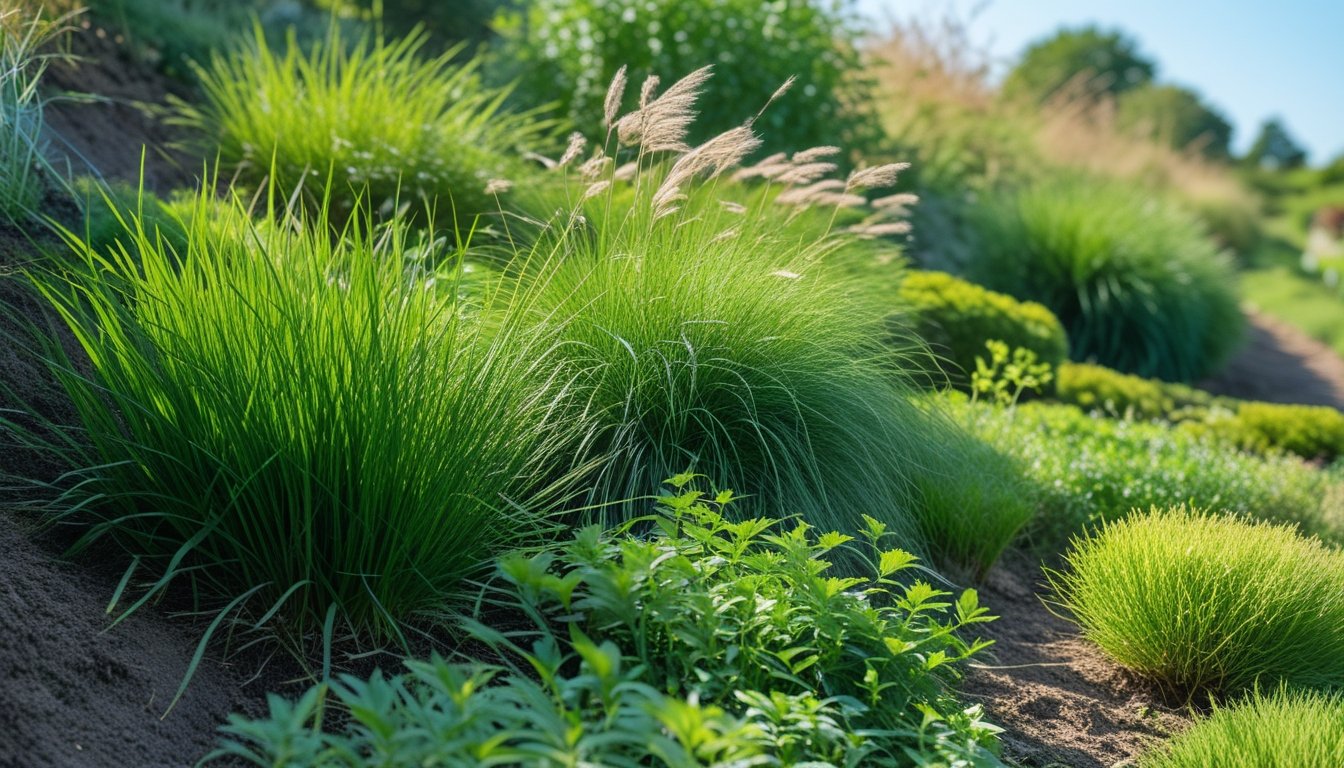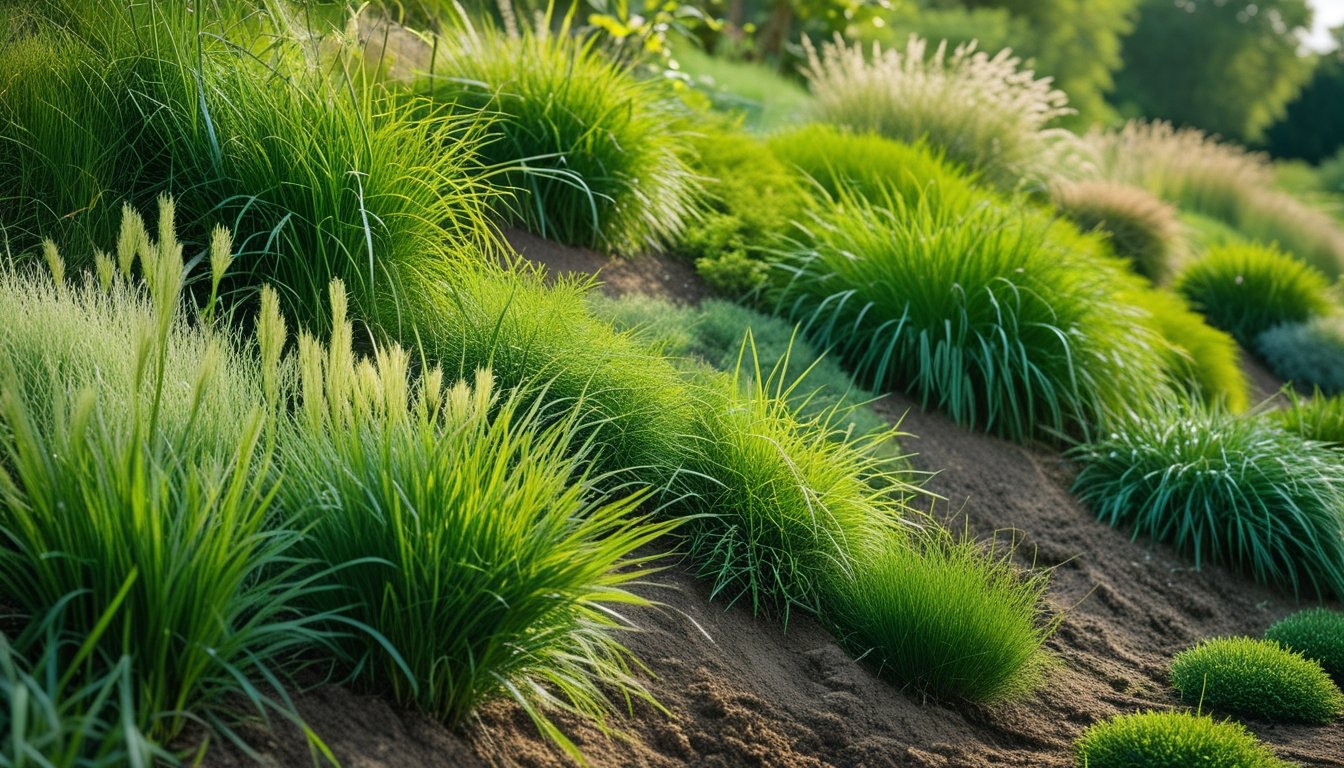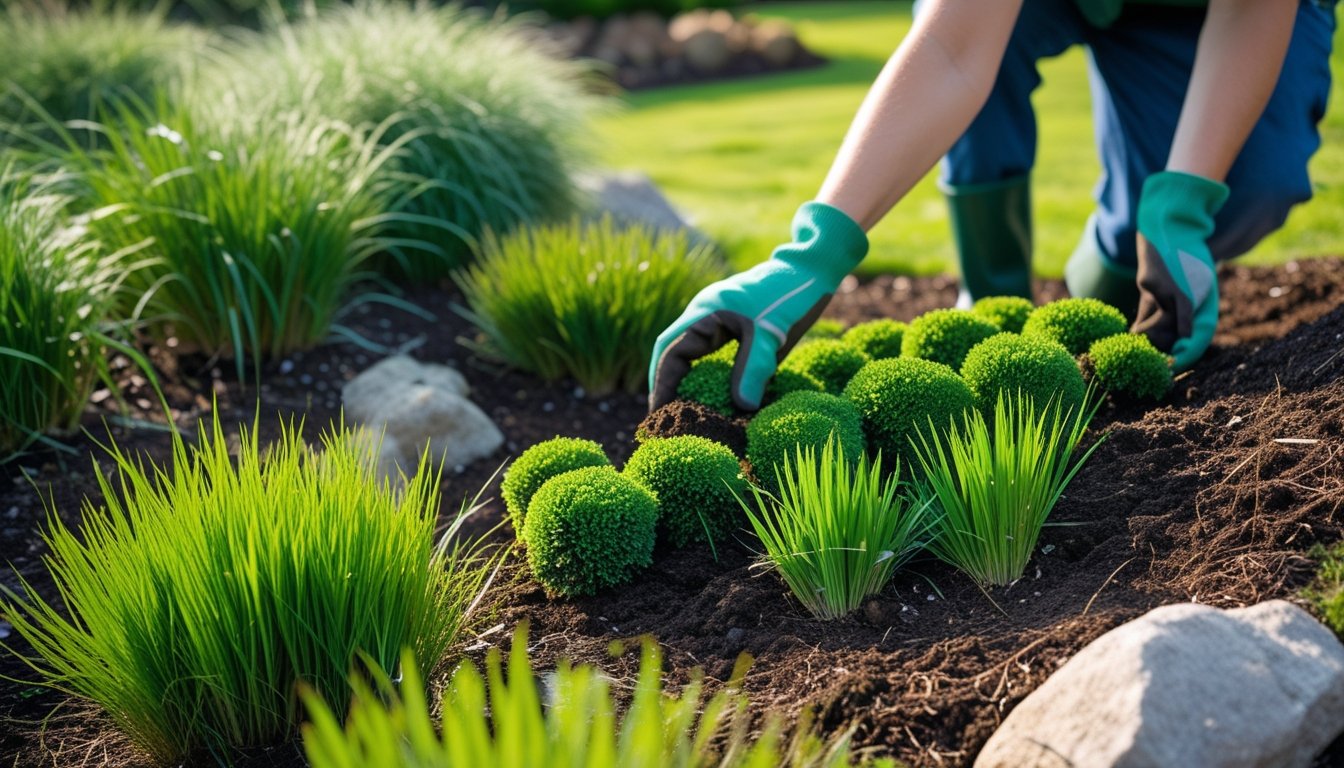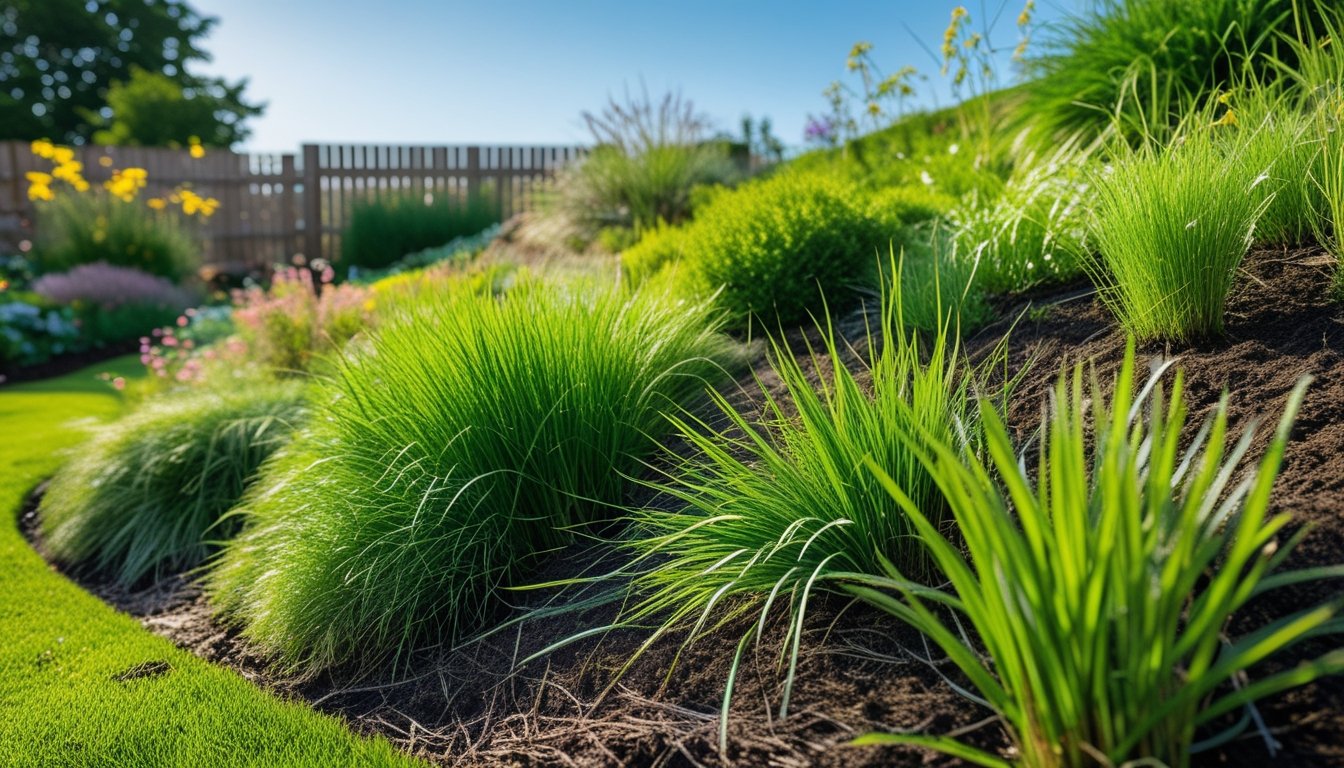Late updated: 11 Oct 2025 12:10
Written by: Emily Thornton
Native UK Grasses For Erosion Control: Effective Solutions For Your Garden
Native UK grasses play a vital role in tackling soil erosion in gardens, offering an eco-friendly solution that is both effective and aesthetically pleasing. As we explore sustainable garden practices, incorporating these native species can enhance biodiversity while ensuring soil stability. Their extensive root systems anchor the soil with remarkable efficiency, reducing the risk of erosion and supporting local ecosystems.

Incorporating these grasses into our garden designs not only helps in soil conservation but also provides a natural habitat for wildlife. Species like Molinia caerulea and Briza media thrive in local climates, requiring minimal maintenance and aligning perfectly with UK gardening conditions. Exploring their unique characteristics and benefits can transform our gardens into resilient and vibrant landscapes.
Selecting the right native grass for our specific garden environment is essential. By understanding the characteristics of each variety and their preferred growing conditions, we can ensure they flourish and perform their protective function effectively. Not only do these grasses stabilize gardens, but they also add texture and movement, enhancing the visual appeal of our outdoor spaces.
Key Takeaways
- Native UK grasses effectively control soil erosion and support biodiversity.
- They are adapted to the local climate, requiring minimal care.
- Selecting the right species enhances soil stability and garden aesthetics.
Native UK Grasses For Erosion Control

In garden environments, native UK grasses play a decisive role in erosion control. With their robust adaptation to local climates, they require minimal maintenance and bring ecological benefits.
How Native Grasses Prevent Soil Erosion
Native UK grasses offer natural erosion control through their structural attributes. Their roots anchor the soil effectively, minimising displacement, especially on slopes and embankments. Unlike synthetic barriers, these grasses provide a sustainable approach. Grass species such as Molinia caerulea (Purple Moor Grass) not only stabilise the soil but also enhance water absorption, reducing runoff during heavy rain. This natural method is particularly effective in garden settings, where maintenance can be a challenge. By integrating these grasses, we create a resilient landscape that is capable of enduring varying weather conditions.
Benefits For Local Biodiversity
Incorporating native grasses into garden spaces also yields important biodiversity benefits. These plants provide habitats and food sources for local wildlife, supporting various species from insects to birds. Their presence encourages healthier ecosystems, fostering an environment where diverse flora and fauna can thrive. Furthermore, native grasses contribute to pollinator activity, which is essential for the reproductive success of many plants in the area. Emphasising the use of native plants in garden design can thus lead to a more dynamic and alive outdoor space, establishing a sanctuary for local biodiversity.
Deep Root Systems and Soil Stability
The impressive root systems of native grasses are key to their effectiveness in maintaining soil stability. These deep and dense roots weave through the soil, creating a robust network that holds the earth together, even in adverse weather conditions. Species like switchgrass and blue grama exhibit especially deep root structures. As a result, they reduce soil erosion by anchoring it firmly, discouraging landslides and soil displacement. This characteristic makes native UK grasses ideal for garden areas prone to erosion, ensuring long-term soil health and stability. By leveraging these grasses, we bolster our garden’s resilience, making them a sustainable choice for erosion management.
Selecting and Planting Native Grasses in Gardens

Integrating native grasses into our gardens enhances erosion control and supports local biodiversity. We'll explore selecting the right species, designing effective planting schemes, and maintaining these plants sustainably.
Choosing The Best Grass Species For Erosion-Prone Areas
Identifying the right species is crucial for effective erosion control. Deschampsia cespitosa (tufted hairgrass) and Molinia caerulea (moor grass) are prime candidates, thriving in moisture-rich soil while stabilising the ground effectively. Their dense root networks bind the soil, reducing erosion risks.
In particularly exposed areas, incorporating Festuca glauca (blue fescue) can offer viable support with its drought resistance. Selecting species like Carex (sedges) ensures that the garden remains both functional and visually appealing year-round.
Popular Native UK Grass Varieties
Several UK native grasses are valued for their adaptability and ornamental qualities. Festuca rubra (red fescue) offers excellent ground cover and requires minimal maintenance, making it a staple in eco-friendly landscaping.
Anthoxanthum odoratum (sweet vernal grass) provides a traditional choice that adds a subtle charm to gardens. For those seeking more structured designs, Pennisetum species add variety with textured plumes that sway in the breeze. Innovatively combining these species can yield visually compelling and functional landscapes.
Designing Effective Planting Schemes
Creating a cohesive planting scheme involves strategic planning. We often utilise Carex and Miscanthus along slopes and water features to prevent soil erosion while framing these features naturally. Stipa tenuissima is perfect for softer boundaries, enhancing movement within the garden.
Layering Panicum with perennials ensures a dynamic, multi-seasonal display. Incorporating Hakonechloa macra offers vibrant ground cover in shaded areas. By combining structural elements with native grass varieties, planting schemes become both practical and aesthetically pleasing.
Maintenance and Sustainable Gardening Practices
Sustainable gardening revolves around minimising intervention. Native grasses require less water, reducing ecological footprints. We focus on minimal fertiliser use and encourage natural soil enrichment processes. Pruning and thinning should be carried out annually to maintain plant health and garden aesthetics.
Mulching with organic materials supports moisture retention and suppresses weeds. Encouraging biodiversity through diversity in planting supports natural pest control. Regular observation and subtle interventions support sustainable garden management, providing resilience with minimal effort.
Frequently Asked Questions

Native UK grasses are excellent for stabilising soil and preventing erosion. Not only are they well-suited to the local environment, but they also support biodiversity and require less maintenance.
Which native British grasses are most effective for preventing soil erosion in domestic gardens?
Several native grasses are particularly effective at preventing soil erosion in gardens. Species such as red fescue, meadow foxtail, and Yorkshire fog have deep root systems that help anchor the soil. These grasses are adapted to the UK climate and can provide long-term erosion control.
How can I incorporate native grasses into my garden's landscaping to combat erosion?
Incorporating native grasses into your garden involves strategic planting along slopes or areas prone to erosion. Use a mix of grasses to cover large areas and establish a dense network of roots. Integrate them with other native plants for added benefits, creating a balanced ecosystem that enhances both aesthetics and soil stability.
What are the ideal growing conditions for erosion-controlling grasses in the UK?
Native UK grasses thrive in a range of conditions but often prefer well-drained soil and moderate sunlight. They can adapt to different pH levels and are generally resistant to local pests and diseases. Ensuring grasses are planted in optimal conditions enhances their ability to prevent erosion and increases their resilience.
What maintenance considerations should be taken into account when using native grasses for soil stabilization?
While native grasses require less maintenance compared to non-natives, regular checks for growth and invasive species are advisable. Occasional weeding and limited mowing can help maintain their health. Monitoring soil health and moisture levels supports their growth, allowing them to continue providing effective erosion control.
Can native UK grass varieties thrive in shaded garden areas while aiding erosion control?
Yes, many native grasses can tolerate shade and are effective in shaded garden areas. Varieties like tufted hairgrass and wood sedge can thrive with limited sunlight. These grasses are well-suited for shaded spots, where they stabilise the soil and prevent erosion.
How does the root structure of native grasses contribute to soil retention in garden environments?
The robust root structures of native grasses play a crucial role in soil retention. Their roots extend deep into the soil, securing it and preventing erosion. The dense network of roots not only holds the soil in place but also improves soil structure and promotes water infiltration, enhancing the garden's overall soil health.
